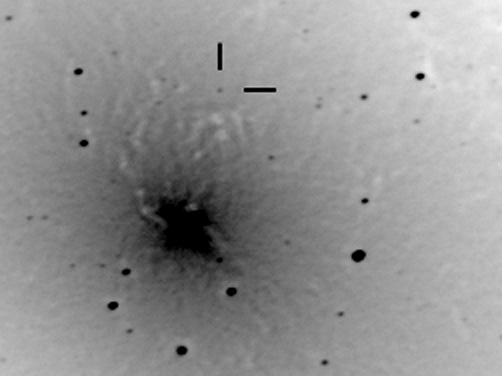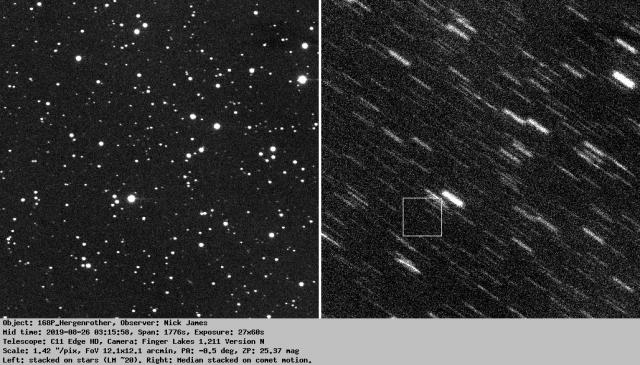Forum Replies Created
-
AuthorPosts
-
 Nick JamesParticipant
Nick JamesParticipantPaul,
I have a VM running Ubuntu 18.04 LTS. I’ll build you a version of the tools in that. Hopefully that will work on your system. If not I’ll have a look at linking the libs statically and, failing all that I’ll give you the source (with an NDA!).
Nick.
 Nick JamesParticipant
Nick JamesParticipantPaul,
If you don’t mind command line software I have written a set of tools which I use as part of my image calibration and processing pipeline. They are based on the cfitsio library so should read any format supported by that library. You can download them from here:
http://www.nickdjames.com/astrolinux/utils.tgz
The stacking tool is called fcombine. The normal syntax to use it is:
fcombine -N -a 611,713 -A 0 -o 0.368,236.7,1.42 200p_ofs FLI*200P*FITThis says:Normalise the median level of each image before stacking, track on a guide star at position 611,713 in the first image, PA of the image is 0 deg (i.e. north up), Offset at 0.368 arcsec/sec in PA 236.7 deg, Pixel scale is 1.42 arcsec/pix. Output file is 200p_ofs and the input files are all files which match FLI*200P*FIT. You can add -F to write as a float fits and -s to do a true average rather than a statistically clipped average. You can also use -v to get a lot of stuff about what it is doing during teh stack (otherwise it is silent). Note that the position for the guide star assumes (1,1) is the top left corner of the image (the convention most amateur software uses) rather than the bottom left (which is what pros tend to use). The FITS standard doesn’t say which is right.
Typing the command with no arguments gives a list of what it can do. For fcombine you get:
fcombine [opts] outfile infiles
By default combines images using mean with outlier rejection
-a x,y[,d] Align on guidestar
-A n[,M] Position angle of image with optional mirroring
-C Cometstack
-c n Crop to image of size nxn
-d n Resample and drizzle by a factor of n
-F Write float format rather than int16
-f file Take alignment offsets from file
-g n Apply gain of n to output
-h Do not use FITS header
-m Minimum pixels
-M Maximum pixels
-n Normalize mean levels by scaling
-N Normalize mean levels by offset
-v Verbose
-V Version
-r n Tracking and PSF radius to use (default = 5.0)
-I Scale to a FITS that IRIS can handle
-R Write output mirror reversed
-o rate,pa,pix Offset (arcsec/min)
-O rate,pa,pix Offset (arcsec/frame)
-p n Add pedestal of n
-P n Reject for PSF > n
-D n Shift step size (default is 1)
-s No outlier rejection
-S n Stacksize (all images by default
-t Align on target Nick JamesParticipant24 September 2019 at 10:13 pm in reply to: Mayo Dark Sky Festival & European Symposium for the Protection of the Night Sky’ #581397
Nick JamesParticipant24 September 2019 at 10:13 pm in reply to: Mayo Dark Sky Festival & European Symposium for the Protection of the Night Sky’ #581397 Nick JamesParticipant
Nick JamesParticipantRonan, I can’t make it this year but I can absolutely commend this meeting to anyone in the BAA who is thinking of going. It covers a subject which is really important to all of us, not only observers but people who value the natural environment. Newport is a great town and the skies are really dark between occasional clouds.
 Nick JamesParticipant
Nick JamesParticipantAmazing that you can get a spectrum at all that close to the bright core. I had my first chance to image it last night and it seems to have faded quite a lot.

 Nick JamesParticipant
Nick JamesParticipantInterestingly someone at ESA implies that this would have been possible in this Twitter thread but I don’t think it is. As I understand it the best case delta-V of comet interceptor from L2 is around 3 km/s. If that was all used as a prograde, in-plane impulse it wouldn’t be enough to raise the aphelion to 2au (the Earth’s velocity around the Sun is around 30 km/s).
 Nick JamesParticipant
Nick JamesParticipantNice idea but the perihelion distance is around 2 au so comet interceptor wouldn’t have been able to get close. I managed to get it this morning despite the annoyingly bright Moon.
 Nick JamesParticipant
Nick JamesParticipantI don’t see that there is any harm in asking for PDF handouts, in the same way that we always ask speakers if we can post their videos. I can understand why some pros don’t want to do this and, if the speaker doesn’t want to have anything online then fine, but I don’t see why you would recommend that we don’t even ask (that is new to me by the way).
 Nick JamesParticipant
Nick JamesParticipantDavid. Thanks for this image. It may not look that impressive but it is extraordinary that we are now able to discover and track objects like this which have come from interstellar space. I’m sure that the pros will be doing everything they can to get a spectrum of this object in the near future. I’ve not been around to image this yet but will try as soon as I get the opportunity. It is not often that you get the opportunity to image a chunk of ice from another star system with an amateur telescope.
 Nick JamesParticipant
Nick JamesParticipantHi Alex, If you or some other willing helper can collect the material I’ll find a way of getting it uploaded to the website. It would certainly be good to get it all in one place.
 Nick JamesParticipant
Nick JamesParticipantNow designated C/2019 Q4 (Borisov) in the MPEC here.
 Nick JamesParticipant
Nick JamesParticipantMike. Yes a great weekend. Good to meet up with everyone and Armagh (City and Observatory) did us proud. I agree about the discussions in the bar afterwards. They are always most productive. Many thanks to our meetings secretary, Hazel Collett, for all the organisation and to the speakers and to everyone from all over GB and Ireland who turned up.
 Nick JamesParticipant
Nick JamesParticipantA really interesting read. Thanks. I particularly like your method of tripod construction!
 Nick JamesParticipant
Nick JamesParticipantThe furthest south declination object I’ve imaged from La Palma is at around -62.2 deg south (see attached). That was about 2000m altitude looking straight down the Caldera de Taburiente.
 Nick JamesParticipant
Nick JamesParticipantWell, I’m very disappointed. Following the story in the Daily Mirror I had a go at imaging this “huge” comet this morning. Nothing was visible to around 20th magnitude. Heavens Above even has finder charts (going to mag 5). A quick Google for Comet 168P brings up a cornucopia of misleading rubbish. What has the Internet done to our common sense?

 Nick JamesParticipant
Nick JamesParticipantThat is a spectacular example of crap “journalism”, even for the Daily Mirror. “your best chance of seeing the comet, look just above the eastern horizon at around 21:15 BST”. Hmmm.
 Nick JamesParticipant
Nick JamesParticipantAs Martin noted the magnitude params computed by the MPC are based mostly on estimates made as a byproduct of doing astrometry. They are therefore generally based on nuclear magnitudes which will be underestimates for comets with larger apparent diameters. The COBS data are generally total magnitudes and the magnitude parameters derived from those are generally better than the MPC ones assuming that there are enough observations to work with. Jonathan uses total magnitudes too and adds a human element and much experience.
The magnitude of a comet depends on its activity level and this can be quite unpredictable. Even well-known periodic comets can behave badly (cf 17P/Holmes). That is what makes them fun to observe! You identified a good example in 289P/Blanpain which was mentioned in the 2019 Handbook with a big warning about its magnitude:
https://britastro.org/system/files/BAA_Handbook_2019_for_web.pdf
C/2017 T2 is another example where the mag params are not well known at the moment:
http://lists.britastro.org/pipermail/comets-disc/2019-August/001319.html
Again, this is why we are observing it.
I guess that the key message is that no fully automated comet prediction website is likely to work. There will always need to be a human element checking what it says and adapting it to the latest observations.
 Nick JamesParticipant
Nick JamesParticipantThat’s a shame. Anyway, I have a deeper image here.
 Nick JamesParticipant
Nick JamesParticipantOn a quick focus frame in a bright sky it appears to be 16.4 unfiltered now.
 Nick JamesParticipant
Nick JamesParticipantThe VPN I currently use is Softether (https://www.softether.org/). I have it running on a hardened Linux box which acts as my border firewall but it will run under pretty much any OS. It is a VPN that operates at the ethernet frame (data-link) layer. It allows you to connect a remote computer to your internal network via the insecure Internet. I have one hardened machine that runs the VPN server and I can then connect through that to the target machine using any protocol that the rules permit (RDP for instance). The observatory PCs are completely isolated from the Internet. I don’t generally allow my observatory or meteor camera PCs to do updates but, as long as I keep my internal network clean, that shouldn’t be a problem.
-
AuthorPosts
